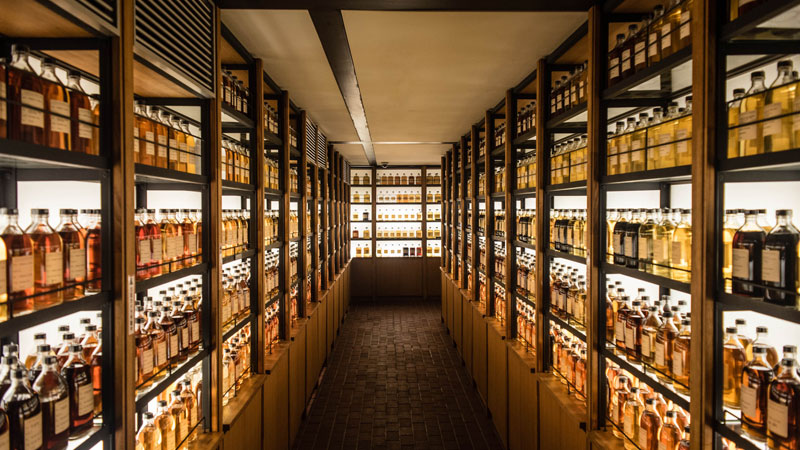“I was scared to death,” Derek Wallace tells me. The New Hampshire man had a major, if enviable problem. He had way too much whiskey.
“I was constantly worried that something bad was going to happen to it,” he says.
There are bottles of booze spread all throughout Wallace’s home. Many of his top-shelf offerings are displayed on a handsome shelving unit in his living room, making them easily accessible, ready to be drunk. Downstairs in his unfinished basement, he has countless bottles wrapped in Parafilm, lined up like bowling pins on the floor.
This is a jaw-dropping amount of bottles to most people, but Wallace is no different from many modern collectors of so-called “brown water.” He’s part of a growing community of spirits enthusiasts choosing to tie up their disposable income in bottles rather than bonds.
Maybe, as Vanity Fair’s A.A. Gill once wrote about modern art collectors, it’s a way to bring “old-money cultural security to emerging-nation new-money insecurity.” Or maybe it’s just a more fun thing to collect in these trying times.
Wallace and his fellow collectors have amassed enough rare and valuable whiskey to require some sort of insurance policy against theft, natural disaster, or plain bad luck. And while anyone with a LeBron-caliber wine cellar or a fleet of Ferraris in their driveway would obviously seek to protect their personal property, spirits insurance is a bit different. It’s a relatively new field, without generations of precedent. The nuances of how whiskey is valued and preserved differ from any other investment, including fine wine.
How, exactly, does one insure a whiskey collection? And what does such a need tell us about the ways we are drinking and spending?
*
For most of history, spirits were ephemeral. You bought a bottle. Drank it. Bought another. When that was done, you bought another. Certain members of the upper crust had well-stocked wine cellars but, for the most part, collecting spirits was not something average Joes did.
Ten or so years ago, however, bourbon emerged as a collectible. Led by Pappy Van Winkle and rare releases from the Buffalo Trace Antique Collection and Four Roses, among others, the category started to appreciate in value. Across the pond, single malt Scotch collecting had already become a strong investment in the 21st century.

With Wallace, and perhaps several thousand others like him, a new frontier of spirits collecting has arrived. One in which bottles aren’t always bought to be consumed.
To cover his collection, Wallace turned to Foy Insurance, a New Hampshire-based company. Foy already provided Wallace’s homeowners insurance, “so basically I needed info on what that covered and what it didn’t,” he says. Like many insurance companies, Foy covers homes as well as the pricey collectibles stored in and around them, such as automobiles, the types of high-end watches people call “timepieces,” and wine and spirits. Other companies, including Chubb and American Collectors Insurance, have begun focusing specifically on collectibles.
“Our company is specialty risk, [we] specifically focus on antiquities,” Dan Mariotti, vice president at Foy Insurance, says. “High-end insurance for high net-worth clientele that standard companies won’t touch.”
Wallace’s extensive whiskey collection was covered as “personal property” on his homeowners insurance if, say, his house burned down. But at that point it would be a lot harder to prove the value of what exactly had been lost.
“In the event of loss, you have to be able prove you owned something,” Mariotti says. “All of the sudden your house burns down, ‘Yeah, yeah, I had 25 bottles of Pappy.’ Right.”
Better to get a specific policy dedicated to whiskey, Wallace figured. And so Mariotti created one for Wallace earlier this year, following a boilerplate his company already uses for wine collectors.
The first step in any policy agreement is valuation. For whiskey, determining the value of a collection is both easier and harder than you’d think. As with any investment market, whiskey valuations fluctuate. Unlike other collectibles, however, whiskey doesn’t have precedents or a commonly agreed-upon resource to speculate value.
Bottles often end being worth more than you pay for them, and certainly worth more than the MSRP. Buffalo Trace, for example, lists its Pappy Van Winkle 15 Year Old for a mere $80. Sounds perfectly reasonable! But you’ll be lucky to ever find it for that cheap. Today the bottle sells on the secondary market for around $900. So that’s its “worth.”
Mariotti compares today’s whiskey market to sports memorabilia. “It’s something that’s only worth what someone else is willing to pay for it,” he says.
Richards believes that whether any person should or should not insure their whiskey collection is ultimately a very personal decision. Some people with a mere $5,000 collection might feel better about putting the financial risk on the insurance company; for others, it might take until their collections get well into the six figures.
One fairly authoritative way of confirming prices so that both parties, client and insurance company, are happy is by examining recent sale prices at Skinner, an auction house with locations in Boston, New York, and Miami. The esteemed L.A. Whisk(e)y Society (LAWS) also offers free appraisals for “substantial” collections in both size and quality, ones well into the thousands of bottles and hundreds of thousands of dollars.
Bottle Blue Book is a more democratic option. The online price guide uses the average of recent, self-reported transactions to determine the current value of something like, say, Four Roses Al Young 50th Anniversary ($560 at the moment) or Booker’s Rye ($760).
When it comes to more obscure vintage bottles, however, a little guesswork is going to have to be done.
“Taking the advice from a professional valuer is the best course of action,” says Alexandra Richards, a specialist on private whisky insurance for Bruce Stevenson. Stevenson is an insurance broker that handles U.K. collections. She notes that a raft of counterfeit bottles of late is making this all the more difficult and necessary.
In St. Moritz last year, a wealthy Chinese traveler paid over $10,000 for a glass of what ended up being a phony Macallan 1878 vintage (the hotel bar was unaware what it had on its hands). I’ve written extensively about the Pappy-refilling scheme that recently infected the bourbon market.
Skinner and LAWS, among others, are more than happy to access the authenticity of rare bottles — and they’ll typically provide this service free of charge. Of course, some collectors are confident in their own abilities to assess legitimacy and quality. “I’m like rain man when it comes to knowing current market value,” Wallace boasts.
All this discussion of pricing whiskey is based on sealed bottles, though. Someone like Wallace — who actually enjoys drinking bourbon and isn’t simply some cynical speculator — also has a large collection of valuable bottles that he has opened.
“Just like wine, once a bottle is opened or uncorked it has no value,” Mariotti says.
Richards agrees. “Once it’s opened, the oxygen is at it and, in order to enjoy it for its full depth of flavor you need to drink it fairly quickly,” she says. “With regards to insurance, as soon as the bottle is opened all coverage ceases.”
On first glance their thinking seems to make sense. At least on the auction market, you can’t resell an open bottle, and thus it has no value to the auction houses. That thinking certainly makes sense in the wine world, where opened product quickly oxidizes.
Whiskey is a little different, however. It will never turn into undrinkable vinegar like wine. It’s even debatable how long it takes for oxygen to ruin it. There are even methods like injecting argon gas into an open bottle that can stave off oxygen permanently.
That’s why, on many private Facebook whiskey buy/sell groups — which are technically illegal, by the way — open bottles still show plenty of value. I’ve seen 2-ounce vials of rare whiskey, like the famed Willett Red Hook Rye, selling for upwards of $400. Thus, many collectors like Wallace believe some of their more valuable open bottles should be assessed at the percentage left of full value.
For anyone who wants to insure their whiskey collection, you’re going to need good records should a tragedy occur. Wallace submitted a highly-detailed Excel spreadsheet of his collection, stored in the cloud, and took numerous images for his own records. He constantly updates these records any time a new bottle comes in or an old one goes out (or gets polished off).
Richards believes the whiskey market is moving so quickly that collections should be reassessed annually, while Mariotti believes it’s up to the client to decide what exactly would be “devastating” to lose and then have the collection reassessed based on that. “If you’ve got hundreds of thousands of dollars’ worth of bottles, you forget to insure a new one you just bought, and it breaks, it is what it is,” he says. “It’s your comfort zone. What would be catastrophic for you to lose?”

*
Today, Wallace feels satisfied with his whiskey coverage, which has been in effect for the last couple of months. “If a pipe broke and flooded the basement I would be covered,” he notes. His policy also “covers breakage during transit or shipping. In theory, the policy would even cover me if [my son] threw a basketball inside the house and shattered some bottles,” he says.
Maybe this piece of mind was all Wallace needed to no longer be “scared to death.” But others, especially during these times of political turmoil and economic uncertainty, may feel more comfortable having their wealth tied up in tangible bottles of Macallan and Ardbeg they sleep a few rooms away from. At the least, if the world starts burning, they’ll have something to drink. You can’t say that about a stock portfolio.
Then again, there are some whiskey collectors who would rather not insure their sizable booze collections at all, lest they accidentally reveal a little too much about their private lives.
A friend who will remain nameless has millions of dollars’ worth of bottles in his San Diego home. He believes if he told his home insurers how much whiskey he was actually storing in his house, they’d quickly change his homeowners insurance policy. That’s because they’d realize that, should his house ever catch fire, it would almost certainly explode and take down the entire neighborhood.
